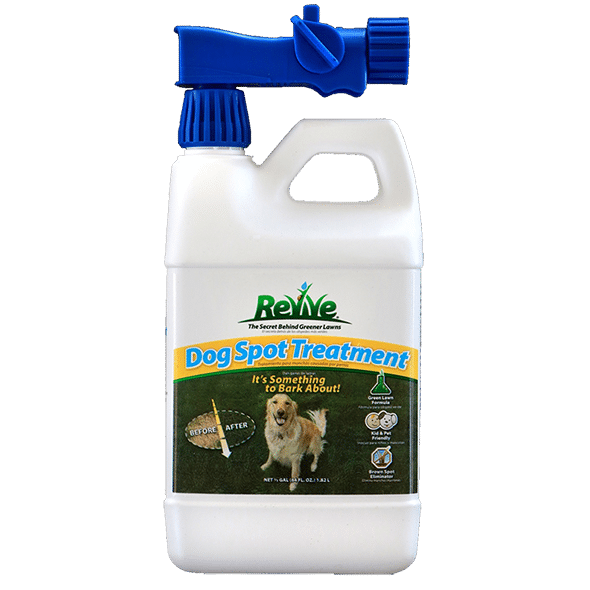Imagine stepping out into your backyard, expecting to be greeted by a lush, verdant lawn, only to find unsightly brown patches that mar its beauty. If this scenario resonates with you, don’t despair; you’re not alone in your struggle against dog urine spots on your lawn. Dog urine is a common culprit of lawn damage, leading to yellowed and withered grass, leaving behind unsightly patches that can detract from the overall aesthetics of your outdoor space.

Image: www.pinterest.com
Dog urine contains high levels of nitrogen, which can have both beneficial and detrimental effects on your lawn. Nitrogen is an essential nutrient for plants, aiding in chlorophyll production, the green pigment responsible for photosynthesis. However, excessive nitrogen can lead to leaf burn, as the grass cannot absorb the nutrients fast enough, resulting in the yellowing of grass blades. Compounding this issue, dog urine also contains salts, which further contribute to the dehydration of grass, exacerbating the damage. The combination of nitrogen and salt creates a double whammy, leading to those dreaded dog spots on your lawn.
While dog urine spots can be a frustrating problem for homeowners, there are effective solutions to restore your lawn to its former glory. With the right approach and a little patience, you can revive your dog-damaged lawn and achieve the lush, green space you desire. In this comprehensive guide, we’ll delve into the best practices for repairing dog spots on your lawn, empowering you with the knowledge and tools to revitalize your outdoor oasis. We’ll cover everything from identifying the affected areas to implementing effective soil amendments and adopting proper lawn maintenance techniques.
1. Stake Out the Problem Areas
The first step in rectifying dog urine damage is to determine the extent of the affected areas. Take a thorough walk around your lawn, carefully inspecting for brown or yellowed patches of grass. These spots may vary in size and shape, but they typically occur in areas where your dog frequently urinates. Once you’ve identified the damaged zones, mark them with stakes or flags for easy reference during the treatment process.
2. Neutralize the Nitrogen
Dog urine’s high nitrogen content is the primary culprit behind lawn damage, so the next step is to neutralize it. Gypsum, a natural mineral, is a widely recommended solution for this task. Gypsum contains calcium sulfate, which reacts with the nitrogen in the soil, converting it into a less harmful form that can be easily absorbed by the grass. Apply gypsum to the affected areas according to the manufacturer’s instructions, and water deeply to help it penetrate the soil.
3. Flush Out the Salts
The salts present in dog urine can further aggravate lawn damage by dehydrating the grass. To combat this, thoroughly water the affected areas with clean water. The extra water will help flush out the salts, diluting their concentration and reducing their harmful effects. After flushing, allow the soil to dry completely before applying any further treatments.
4. Aerate and De-thatch
Aerating and de-thatching are essential steps for improving the overall health of your lawn, including the dog-damaged areas. Aeration involves poking holes into the soil, creating pathways for air, water, and nutrients to reach the roots of the grass. De-thatching removes the layer of dead grass and debris that accumulates on the soil’s surface, preventing water and nutrients from reaching the roots. Both aeration and de-thatching promote healthy root growth, strengthening the grass and making it more resistant to damage.
5. Reseed or Over-seed
If the dog urine damage is severe and has killed the grass, you may need to reseed or over-seed the affected areas. Reseed involves removing the damaged grass and replanting new grass seeds. Over-seeding involves spreading grass seeds over existing grass to thicken the lawn and fill in bare patches. Water the seeded areas regularly, especially during the germination period, to ensure successful establishment of new grass.
6. Fertilize for Recovery
Once the affected areas have been reseeded or over-seeded, fertilize the entire lawn to promote healthy growth. Choose a fertilizer specially formulated for lawns, ensuring it contains essential nutrients such as nitrogen, phosphorus, and potassium. Follow the instructions on the fertilizer label for proper application and dosage. By providing the necessary nutrients, you’ll stimulate root development and encourage the grass to recover and thrive.
7. Preventive Measures for a Healthy Lawn
While dog urine spots can be a recurring problem, there are steps you can take to minimize their occurrence and maintain a healthy lawn. Encourage your dog to urinate in designated areas by providing a specific spot with gravel or artificial grass. Train your dog to use this area by offering treats or praise when they do. If your dog continues to urinate in undesired areas, consider using a repellent spray specifically designed to discourage dogs from urinating in those spots.
Conclusion
Restoring your dog-damaged lawn to its former glory requires a combination of targeted treatments and proper lawn maintenance practices. By following the steps outlined in this comprehensive guide, you can effectively neutralize the effects of dog urine, promote grass recovery, and enjoy a lush, healthy lawn. Remember to be patient, as lawn repair takes time and consistent effort. With the right approach and a little dedication, you can achieve a beautiful outdoor space that both you and your furry friend can enjoy.

Image: animalia-life.club
How To Fix Dog Spots On Lawn